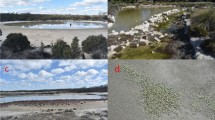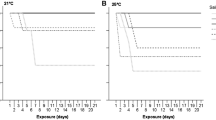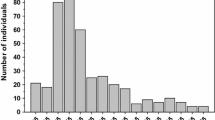Abstract
The tolerance to high salinity of older life stage macroinvertebrates could underestimate the effects of increasing salinity on freshwater macroinvertebrates. The salinity tolerance of the eggs and/or hatchlings of Glyptophysa gibbosa (Planorbidae), Glyptophysa aliciae, Glacidorbis sp. (Glacidorbidae), a Glossiponiidae, Piona cumberlandis (Pionidae), and Chironomus sp. (Chironomidae) were determined. The salinity tolerances of younger life-stages of species studied here and elsewhere were then compared to salinity tolerances of their mature aquatic or dominant life-stage. A diversity of responses have been observed with some species having similar salinity tolerances in all life-stages examined, whilst the eggs or hatchlings of other species had salinity tolerances ranging from 4% to 88% of their older life stages. On present knowledge, this diversity of responses presents some difficulties for simple rules of thumb to approximate sensitivity of young life-stages of freshwater macroinvertebrates inferred from their dominant stage’s tolerance.







Similar content being viewed by others
Abbreviations
- DI:
-
deionised
- EC:
-
electrical conductivity
- HC50 :
-
concentration to reduce hatching of eggs by 50%
- LC50 :
-
concentration lethal to 50% of individuals
- PFCH:
-
period for complete hatching
- RW:
-
River water
- WLW:
-
wet lab water
References
Bayly IAE, Williams WD (1973) Inland waters and their ecology. Longman Australia Pty Limited, Hawthorn, Australia
Berezina NA (2003) Tolerance of freshwater invertebrates to changes in water salinity. Russ J Ecol 34:261–266
Clark TM, Flis BJ, Remold SR (2004) Differences in the effects of salinity on larval growth and developmental programs of a freshwater and a euryhaline mosquito species (Insecta: Diptera, Culicidae). J Exp Biol 207:2289–2295
Forbes VE, Calow P (2002) Extrapolation in ecological risk assessment: balancing pragmatism and precaution in chemical controls legislation. BioScience 52:249–257
Goetsch P-A, Palmer CG (1997) Salinity tolerances of selected macroinvertebrates of the Sabie River, Kruger National Park, South Africa. Archs Envir Contam Toxicol 32:31–41
Haage P (1968) On the salinity tolerance of eggs and young larvae of Phryganea grandis Linne (Trichoptera). Hydrobiologia 32:257–270
Haage P (1969) Salinity preference and tolerance of caddis larvae (Trichoptera). Opuscula Entomologica 34:73–89
Hart BT, Bailey P, Edwards R, Hortle K, James K, McMahon A, Meredith C, Swadling K (1991) A review of salt sensitivity of Australian freshwater biota. Hydrobiologia 210:105–144
Hall CJ, Burns CW (2002) Mortality and growth responses of Daphnia carinata to increases in temperature and salinity. Freshw Biol 47:451–458
Harvey MS (1998) The Australian water mites: a guide to families and genera. Monographs on Invertebrate Taxonomy, Volume 4. CSIRO Publishing, Collingwood, Australia
Hubschman JH (1975) Larval development of the freshwater shrimp Palaemonetes kadiakensis Rathbun under osmotic stress. Physiol Zool 48:97–104
James KR, Cant B, Ryan T (2003). Responses of freshwater biota to rising salinity levels and implications for saline water management: a review. Aust J Bot 51:703–713
Kefford BJ, Papas PJ, Nugegoda D (2003) Relative salinity tolerance of macroinvertebrates from the Barwon River, Victoria, Australia. Mar Freshw Res 54:755–765
Kefford BJ, Nugegoda D (2005) Lack of critical salinity thresholds: effects of salinity on growth and reproduction of the freshwater snail Physa acuta. Environ Pollut 54:755–765
Kefford BJ, Dalton A, Palmer CG, Nugegoda D (2004a) The salinity tolerance of eggs and hatchlings of selected aquatic macroinvertebrates in south-east Australia and South Africa. Hydrobiologia 517:179–192
Kefford BJ, Palmer CG, Pakhomova L, Nugegoda D (2004b) Comparing different approaches to measuring the salinity tolerance of freshwater invertebrates. Water SA 30:499–506
Kefford BJ, Palmer CG, Nugegoda D (2005a) Relative salinity tolerance of freshwater macroinvertebrates in the south-east of the Eastern Cape, South Africa and in the Barwon Catchment, Victoria, Australia. Mar Freshw Res 56:163–171
Kefford BJ, Palmer CG, Jooste S, Warne MStJ, Nugegoda D (2005b) What is it meant by ‘95% of species’? An argument for the inclusion of rapid tolerance testing. Hum Ecolog Risk Assess 11:1025–1046
Kefford BJ, Nugegoda D, Metzeling L, Fields EJ (2006) Validating species sensitivity distributions using salinity tolerance of riverine macroinvertebrates in the southern Marray Darling Basin (Victoria, Australia). Can J Fish Aquat Sci 63:1865–1877
Komnick H, Wichard W (1975) Chloride cells of larva Notonecta glauca and Naucoris cimicoides (Hemiptera, Hyrocorisae) fine structure and cell counts at different salinities. Cell Tissue Res 156:539–549
Madsen H (1987) Effect of calcium concentration on growth and egg laying of Helisoma duryi, Biomphalaria alexandrina, B. camerunensis and Bulinus truncatus (Gastropoda: Planorbidae). J Appl Ecol 24:823–836
Pinder AM, Halse SA, McRae JM, Shiel RJ (2005) Occurrence of aquatic invertebrates of the wheatbelt region of Western Australia in relation to salinity. Hydrobiology 543:1–24
Ross LF, Harrison AD (1977) Effects of environmental calcium deprivation of the egg masses of Physa marmorata Guilding (Gastropoda: Physidae) and Biomphalaria glabrata Say (Gastropoda: Planorbidae). Hydrobiologia 55:45–48
Smith PJ (2002) Analysis of failure and survival data. Chapman and Hall, Boca Raton
Sunderam RM, Patra RW, Julli M, Warne MStJ (2004) Use of the up- and- down acute toxicity test procedure to generate LC50 data for fish. Bull Envir Contam Toxicol 72:873–880
VWRDC (2004) Victorian Water Resources Data Warehouse. Victoria, Australia. Available from: http://www.vicwaterdata.net/
Walsh CJ (1994) Ecology of epifauna caridean shrimps in the Hopkins River estuary, and the role of estuaries in the life history of the Atyid Paratya australiensis Kemp, 1917 in South-Eastern Australia. PhD Thesis, Deakin University, Australia
Walsh CJ, Mitchell BD (1995) The freshwater shrimp Paratya australiensis (Kemp 1917) (Decapoda: Atyidae) in estuaries of south-western Victoria, Australia. Mar Freshw Res 46:959–965
Walter DE, Proctor HC (1999) Mites ecology, evolution and behaviour. University of New South Wales Press Ltd, Sydney, Australia
Williams WD (1987) Salinization of rivers and streams: an important environmental hazard. Ambio 16:180–185
Acknowledgments
We are grateful to Land and Water Australia and the Murray Darling Basin Commission who funded this study under the National River Contaminants Program (project no. RMI 12), as well as additional funds from the Queensland Department of Natural Resources and Mines. We particularly thank Colin Clay for his early assistance in this project. We thank Winston Ponders (Gastropods) and Mark Harvey (Mites) for confirming the identifications of specimens. The project benefited from a steering committee consisting of Satish Choy, Brendan Edgar, Richard Marchant, Leon Metzeling, Daryl Nielsen, Carolyn Palmer and Phil Papas and discussions with Jason Dunlop and Nelli Horrigan.
Author information
Authors and Affiliations
Corresponding author
Rights and permissions
About this article
Cite this article
Kefford, B.J., Nugegoda, D., Zalizniak, L. et al. The salinity tolerance of freshwater macroinvertebrate eggs and hatchlings in comparison to their older life-stages: a diversity of responses. Aquat Ecol 41, 335–348 (2007). https://doi.org/10.1007/s10452-006-9066-y
Received:
Accepted:
Published:
Issue Date:
DOI: https://doi.org/10.1007/s10452-006-9066-y




